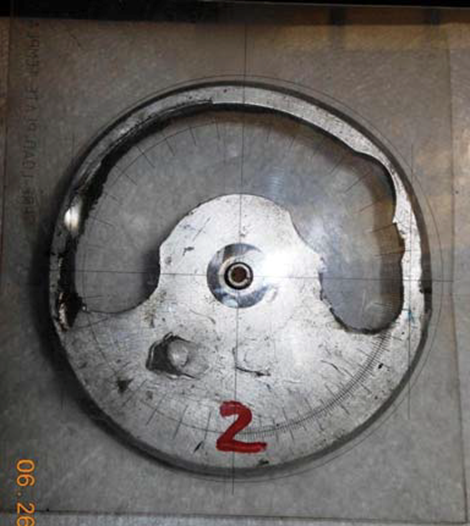Determining Propeller Blade Angle at Impact
When accident investigators examine a crash scene, one of the most important tasks is reconstructing the power condition of the engines. For constant-speed propellers, this often involves determining the blade angle at impact. Careful examination of the propeller hub can reveal witness marks—physical traces left during sudden deceleration—that help investigators answer crucial questions about flight performance and engine operation.
Step 1: Removal and Initial Examination
The process begins with the removal of the propeller hub from the engine. Once disassembled (under the watchful eye of a subject matter expert- there are springs that hold tremendous energy within the hub) investigators inspect the preload plate, blade pins, and pitch-change forks. These components often show evidence of high-force contact during impact, leaving behind telltale markings.
Step 2: Identifying Witness Marks
Witness marks may appear as smears, indentations, or scoring. They can be found on:



Step 3: Measuring with a Protractor
To interpret these marks, investigators use a blade-angle protractor (such as the Hartzell BST-2960-3). The tool is aligned with a hub reference—commonly the split line or a designated cutout. The angular position of the witness mark is then read directly.

Preload plate with visible witness marks and a protractor aligned to hub reference.
Step 4: Interpretation
Determining blade angle helps investigators establish whether:
Conclusion
By removing the hub, locating witness marks, and applying calibrated protractor measurements, investigators can accurately determine propeller blade angle at impact. These findings are essential for understanding engine performance and pilot actions during the accident sequence and should be combined with corroborating evidence from other components.
At Southern California Safety Institute, we use these techniques in training to give investigators and safety professionals the hands-on skills needed for accurate accident investigation and reconstruction.
Go Back Step 1: Removal and Initial Examination
The process begins with the removal of the propeller hub from the engine. Once disassembled (under the watchful eye of a subject matter expert- there are springs that hold tremendous energy within the hub) investigators inspect the preload plate, blade pins, and pitch-change forks. These components often show evidence of high-force contact during impact, leaving behind telltale markings.
Step 2: Identifying Witness Marks
Witness marks may appear as smears, indentations, or scoring. They can be found on:
- The butt ends of the propeller blades, where the pins press into the preload plate.
- The hub yoke or fork bumpers, which arrest blade motion.
- The preload plate surface, where heavy contact occurs.



Step 3: Measuring with a Protractor
To interpret these marks, investigators use a blade-angle protractor (such as the Hartzell BST-2960-3). The tool is aligned with a hub reference—commonly the split line or a designated cutout. The angular position of the witness mark is then read directly.

Preload plate with visible witness marks and a protractor aligned to hub reference.
Step 4: Interpretation
Determining blade angle helps investigators establish whether:
- The engine was producing power at impact.
- The propellers were in a low-pitch (takeoff/climb) or high-pitch (cruise) setting.
- Asymmetrical blade positions may have contributed to loss of control.
Conclusion
By removing the hub, locating witness marks, and applying calibrated protractor measurements, investigators can accurately determine propeller blade angle at impact. These findings are essential for understanding engine performance and pilot actions during the accident sequence and should be combined with corroborating evidence from other components.
At Southern California Safety Institute, we use these techniques in training to give investigators and safety professionals the hands-on skills needed for accurate accident investigation and reconstruction.
